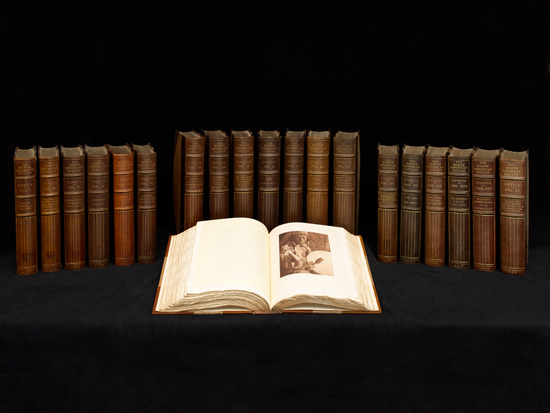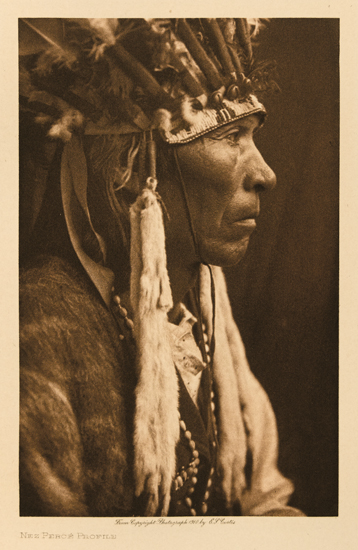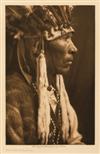Sale 2180 - Lot 11
Unsold
Estimate: $ 250,000 - $ 350,000
CURTIS, EDWARD S.
The North American Indian, Being a Series of Volumes Picturing and Describing the Indians of the United States and Alaska. Volumes 1-20.
Written, Illustrated and Published by Edward S. Curtis. Edited by Frederick Webb Hodge. Foreword by Theodore Roosevelt. Each lavishly illustrated with sepia-toned photogravures on Van Gelder paper. Large 4tos, 3/4 gilt-lettered morocco. Roth 36; Parr/Badger I 73; Hasselblad 48; Auer 94. set number 130 of a planned edition of 500 copies, volume one signed by edward s. curtis.
Cambridge, Massachusetts: (The University Press), 1907-1930
The North American Indian, Being a Series of Volumes Picturing and Describing the Indians of the United States and Alaska. Volumes 1-20.
Written, Illustrated and Published by Edward S. Curtis. Edited by Frederick Webb Hodge. Foreword by Theodore Roosevelt. Each lavishly illustrated with sepia-toned photogravures on Van Gelder paper. Large 4tos, 3/4 gilt-lettered morocco. Roth 36; Parr/Badger I 73; Hasselblad 48; Auer 94. set number 130 of a planned edition of 500 copies, volume one signed by edward s. curtis.
Cambridge, Massachusetts: (The University Press), 1907-1930
Additional Details
Vol. 1: Apache, Jicarillas, Navaho; Vol. 2: Pima, Papago, Qahatika, Mohave, Yuma, Maricopa, Walapi, Havasupai, Apache-Mohave; Vol. 3: Teton Sioux, Yanktonai, Assiniboin; Vol. 4: Apsaroke, Hidatsa; Vol. 5: Mandan, Arikara, Atsina; Vol. 6: Piegan, Cheyenne, Arapaho; Vol. 7: Yakima, Klickitat, Interior Salish, Kutenai; Vol. 8: Nez Percés, Walla Walla, Umatilla, Cayuse, Chinookan Tribes; Vol. 9: Salishan Tribes of the Coast, Chimakum, Quilliute, Willapa; Vol. 10: The Kwakiutl; Vol. 11: Nootka, Haida; Vol. 12: The Hopi; Vol. 13: Hupa, Yurok, Karok, Wiyot, Tolowa, Tututni, Shasta, Achomawi, Klamath; Vol. 14: Kato, Wailaki, Yuki, Pomo, Wintun, Maidu, Miwok, Yokuts; Vol: 15: Southern California Shoshoneans, The Dieguenos, Plateau Shoshoneans, The Washo Mythology; Vol. 16: The Tiwa, The Keres; Vol. 17: The Tewa, The Zuñi; Vol. 18: The Chipewyan, The Western woods Cree, The Sarsi; Vol. 19: The Indians of Oklahoma, The Wichita, The southern Cheyenne, The Oto, The Comanche, The Peyote cult; Vol. 20: The Alaskan Eskimo, The Nunivak, The Eskimo of Hooper Bay, The Eskimo of King Island, The Eskimo of Little Diomede Island, The Eskimo of Cape Prince of Wales, The Kotzebue Eskimo, The Noatak, The Kobuk, The Selawik
In the field of photographic literature, Edward S. Curtis's 20-volume set, "The North American Indian," is legendary. Curtis' celebrated use of the photogravure, the most sophisticated of the photomechanical techniques (and the same process employed by Alfred Stieglitz on the pages of "Camera Work") depicts Native American figures with startling verisimilitude. His remarkable aesthetic reformulated the photobook as one in which images and text were considered equal partners.
When Curtis first conceived of a project documenting "the vanishing race," he sought assistance from J.P. Morgan and Theodore Roosevelt. Morgan, an avid bibliophile, is said to have instructed the young photographer, "Mr. Curtis, I want to see these photographs in the most beautiful set of books ever published." Curtis did not disappoint his patron. With its rich leather morocco binding, artistically-rendered images, and gilt highlights, each volume is a tour-de-force, reflecting both Curtis's passion for his subject matter and insistence on the highest production values available. He also served as ethnographer, musicologist and linguist, writing his detailed observations of Native American life, which were highlighted with transcriptions of songs and a lexicon of indigenous languages.
The set offered in this lot belonged to the railroad magnate James J. Hill (1838-1916). In 1878, Hill and his investors purchased the St. Paul and Pacific Railroad, later renaming it the Great Northern Railway Company. A successful businessman who had an abiding respect for the western landscape and native culture, he was an early supporter of the 1908 doctrine of conservation of natural resources.
The single owner set, number 130 from an edition of 272 (of the proposed edition of 500), is on Van Gelder paper. Each of the volumes has a perforated library stamp on the margin of the title page, and Volume I is signed by Edward S. Curtis.
From the Collection of James J. Hill; to the Hill Library; St. Paul, Minnesota; to A Gallery for Fine Photography, New Orleans, Louisiana; to Bernard's Gallery, Calabasas, California.
For photographs by Curtis, please see lots 164-185.
In the field of photographic literature, Edward S. Curtis's 20-volume set, "The North American Indian," is legendary. Curtis' celebrated use of the photogravure, the most sophisticated of the photomechanical techniques (and the same process employed by Alfred Stieglitz on the pages of "Camera Work") depicts Native American figures with startling verisimilitude. His remarkable aesthetic reformulated the photobook as one in which images and text were considered equal partners.
When Curtis first conceived of a project documenting "the vanishing race," he sought assistance from J.P. Morgan and Theodore Roosevelt. Morgan, an avid bibliophile, is said to have instructed the young photographer, "Mr. Curtis, I want to see these photographs in the most beautiful set of books ever published." Curtis did not disappoint his patron. With its rich leather morocco binding, artistically-rendered images, and gilt highlights, each volume is a tour-de-force, reflecting both Curtis's passion for his subject matter and insistence on the highest production values available. He also served as ethnographer, musicologist and linguist, writing his detailed observations of Native American life, which were highlighted with transcriptions of songs and a lexicon of indigenous languages.
The set offered in this lot belonged to the railroad magnate James J. Hill (1838-1916). In 1878, Hill and his investors purchased the St. Paul and Pacific Railroad, later renaming it the Great Northern Railway Company. A successful businessman who had an abiding respect for the western landscape and native culture, he was an early supporter of the 1908 doctrine of conservation of natural resources.
The single owner set, number 130 from an edition of 272 (of the proposed edition of 500), is on Van Gelder paper. Each of the volumes has a perforated library stamp on the margin of the title page, and Volume I is signed by Edward S. Curtis.
From the Collection of James J. Hill; to the Hill Library; St. Paul, Minnesota; to A Gallery for Fine Photography, New Orleans, Louisiana; to Bernard's Gallery, Calabasas, California.
For photographs by Curtis, please see lots 164-185.
Exhibition Hours
Exhibition Hours
Aliquam vulputate ornare congue. Vestibulum maximus, libero in placerat faucibus, risus nisl molestie massa, ut maximus metus lectus vel lorem.






